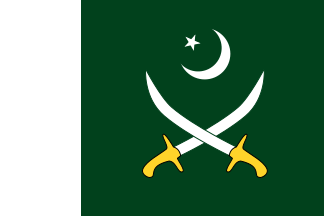20th Lancers (Pakistan)
| 20th Lancers | |
|---|---|
 | |
| Active | 1922 - 1937; 1956 - Present |
| Country |
|
| Branch | Army |
| Type | Armoured Regiment |
| Size | Regiment |
| Engagements |
Indian Mutiny of 1857 Bhutan War 1864-65 Second Afghan War 1878-80 First World War 1914-18 Indo-Pakistani War of 1965 Indo-Pakistani War of 1971 |
| Battle honours | Charasiah, Kabul 1879, Afghanistan 1878-80, Neuve Chapelle, France and Flanders 1914-15, Kut al Amara 1917, Sharqat, Mesopotamia 1916-18, Persia 1916-19, NW Frontier, India 1915, Sialkot 1965, Shakargarh 1971.[1] |
The 20th Lancers is an armoured regiment of the Pakistan Army.
As part of a reorganization of the British Indian Army, the original 20th Lancers was formed in 1922 by the amalgamation of the 14th Murray's Jat Lancers and the 15th Lancers (Cureton's Multanis).[2]
The modern regiment was formed in 1956.
Predecessor
After the First World War, the number of cavalry regiments of the British Indian Army was reduced from thirty-nine to twenty-one. However, instead of disbanding the surplus units, it was decided to amalgamate them in pairs. This resulted in renumbering and renaming of the entire cavalry line. 20th Lancers was formed in 1921 by the amalgamation at Sialkot on 21 September 1920 - the 14th Murray's Jat Lancers, raised at Aligarh as the Jat Horse Yeomanry in 1857 during the Indian Mutiny and composed entirely of Hindu Jats,[2] and the 15th Lancers (Cureton's Multanis), which was formed at Lahore in 1858 from Multani Pathans originally raised in 1857 as The Multani Regiment of Cavalry.[2][3]
The new class composition of the regiment was one squadron each of Punjabi Muslims, Jat Sikhs and Hindu Jats. The uniform of 20th Lancers was dark blue with scarlet facings. The badge consisted of crossed silver lances bearing pennons with a crown at the intersection above "XX" and a scroll below. In 1937, 20th Lancers became the training regiment of 3rd Indian Cavalry Group at Lucknow. It was converted into a training centre in 1940 and transferred to India after Partition of India and Pakistan.[2][4]
.jpg)
Reformation
On 20 June 1956, 20th Lancers was re-raised by Pakistan Army as a Reconnaissance Regiment of Pakistan Armoured Corps and equipped with M24 Chaffee light tanks.[5] The same year, the Indian Army raised an armoured regiment, named as 20 Lancers, as the successor of the pre-independence 20th Lancers. The honour to raise the regiment for the Pakistan Armored Corps went to Major Syed Azmat Ali Bokhari; Major Bokhari also commanded a squadron of the regiment during the 1965 war on the Sialkot front. At the time of re-raising in 1956, the original badge was retained with the exception of the crown.
Operations
During the Indo-Pakistani War of 1965, the regiment, equipped with M36B2 tank destroyers served under 15th Infantry Division in the Sialkot Sector. The regiment took part in the stubborn defence of Sialkot Cantonment and Dallowali Railway Station during which the regiment lost fifteen lives. For this feat of arms, the regiment was awarded the battle honour Sialkot 1965.[5][6]
During the Indo-Pakistani War of 1971, 20th Lancers was part of 8th Infantry Division (Pakistan) in the Shakargarh-Zafarwal Sector and formed part of a delaying force tasked to prevent enemy intrusion between Deg Nadi and River Bein for 48 hours. The regiment tenaciously held up the invading Indian divisions for two weeks against repeated attacks,losing sixteen lives. The regiment was subsequently awarded the battle honour Shakargarh 1971. Sowar Muhammad Hussain was awarded a posthumous Nishan-i-Haider for outstanding gallantry, the only occasion in which this award was won by the Pakistan Armoured Corps.[5][6]
Affiliations & Alliances
![]() The Punjab Regiment
The Punjab Regiment
In 1990, the 20th Lancers were given permission to add the suffix Haidri to its title. It was also affiliated to the Punjab Regiment as a mark of recognition of the battlefield camaraderie between the 13th Battalion, Punjab Regiment and 20th Lancers in Shakargarh in 1971. The expanded title of 20th Lancers is now "20th Lancers (Haidri) (Punjab)".[5]
References & Notes
- ↑ Rodger, Alexander. (2003). Battle Honours of the British Empire and Commonwealth Land Forces 1662-1991. Ramsbury: The Crowood Press.
- 1 2 3 4 Gaylor, John (1991). Sons of John Company: The Indian and Pakistan Armies 1903–91. Stroud: Spellmount.
- ↑ Harris, RG, and Warner, C. (1979). Bengal Cavalry Regiments 1857–1914. London: Osprey.
- ↑ Sandhu, Maj Gen GS. (1981). The Indian Cavalry: History of the Indian Armoured Corps till 1940. New Delhi: Vision Books.
- 1 2 3 4 Nath, Ashok (2009). Izzat: historical records and iconography of Indian cavalry regiments, 1750-2007. Centre for Armed Forces Historical Research, United Service Institution of India. pp. 731–732. ISBN 978-81-902097-7-9.
- 1 2 The Sabre & Lance: Journal of the Pakistan Armoured Corps. (1997). Nowshera: The School of Armour & Mechanised Warfare.
Further reading
- Gaylor, John (1991). Sons of John Company: The Indian and Pakistan Armies 1903- 1991. Stroud: Spellmount Publishers Ltd. ISBN 978-0-946771-98-1
- Harris, RG, and Warner, C. (1979). Bengal Cavalry Regiments 1857–1914. London: Osprey Publishing. ISBN 978-0-85045-308-9.
- 15th Lancers (Cureton’s Multanis) 1858-1908. (1910). Calcutta: Superintendent of Government Printing.
- Sandhu, Maj Gen GS. (1981). The Indian Cavalry: History of the Indian Armoured Corps till 1940. New Delhi: Vision Books.
- Cardew, FG. (1903). A Sketch of the Services of the Bengal Native Army to the Year 1895. Calcutta: Military Department.
- Kempton, C (1996). A Register of Titles of the Units of the H.E.I.C. & Indian Armies 1666-1947. Bristol: British Empire & Commonwealth Museum. ISBN 978-0-9530174-0-9
